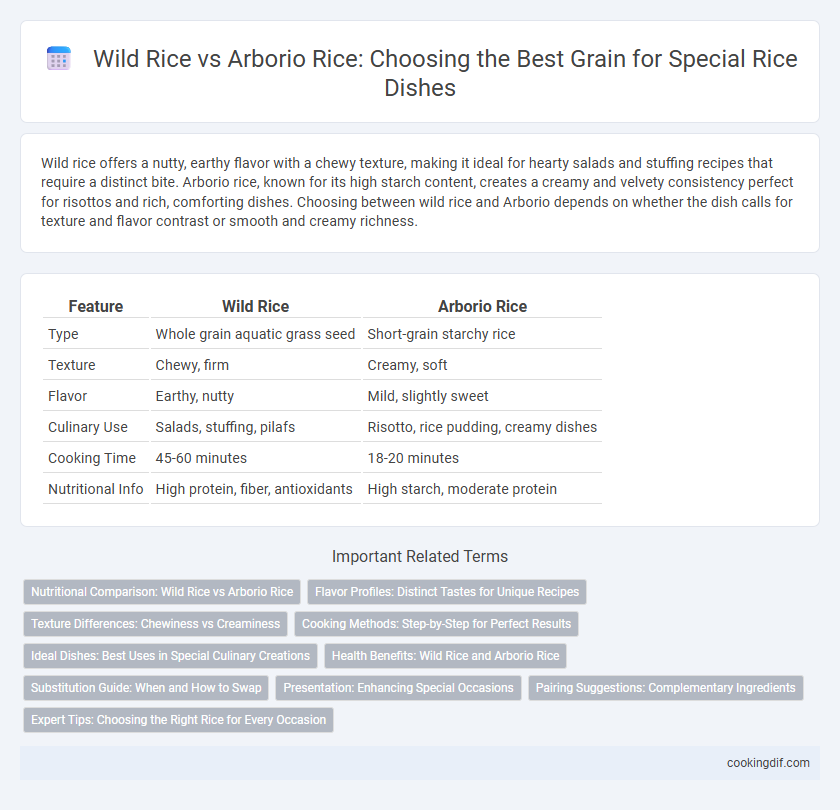Wild rice offers a nutty, earthy flavor with a chewy texture, making it ideal for hearty salads and stuffing recipes that require a distinct bite. Arborio rice, known for its high starch content, creates a creamy and velvety consistency perfect for risottos and rich, comforting dishes. Choosing between wild rice and Arborio depends on whether the dish calls for texture and flavor contrast or smooth and creamy richness.
Table of Comparison
| Feature | Wild Rice | Arborio Rice |
|---|---|---|
| Type | Whole grain aquatic grass seed | Short-grain starchy rice |
| Texture | Chewy, firm | Creamy, soft |
| Flavor | Earthy, nutty | Mild, slightly sweet |
| Culinary Use | Salads, stuffing, pilafs | Risotto, rice pudding, creamy dishes |
| Cooking Time | 45-60 minutes | 18-20 minutes |
| Nutritional Info | High protein, fiber, antioxidants | High starch, moderate protein |
Nutritional Comparison: Wild Rice vs Arborio Rice
Wild rice contains higher protein, fiber, and antioxidant levels compared to Arborio rice, making it a nutrient-dense choice for health-conscious dishes. Arborio rice, with its high starch content, excels in creamy textures ideal for risottos but offers fewer vitamins and minerals than wild rice. Choosing between wild rice and Arborio rice depends on whether nutritional value or culinary texture is prioritized in special recipes.
Flavor Profiles: Distinct Tastes for Unique Recipes
Wild rice offers a nutty, earthy flavor with a chewy texture, making it ideal for hearty salads, stuffing, and rustic soups. Arborio rice provides a creamy, rich taste due to its high starch content, perfect for risottos and dishes requiring a smooth, velvety finish. Choosing between these rices depends on the desired flavor intensity and texture, enhancing the uniqueness of special recipes.
Texture Differences: Chewiness vs Creaminess
Wild rice offers a firm, chewy texture that holds up well in salads and pilafs, providing a nutty flavor and distinct bite. Arborio rice, known for its high starch content, delivers a creamy, smooth consistency ideal for risottos and seafood dishes. Choosing between wild rice and Arborio hinges on the desired mouthfeel: chewy robustness versus rich creaminess.
Cooking Methods: Step-by-Step for Perfect Results
Wild rice requires prolonged soaking and a simmering process of 45-60 minutes to achieve a tender, chewy texture ideal for pilafs and salads, while Arborio rice demands a gradual addition of warm broth during a 20-25 minute stirring technique to release its creamy starch for risottos. Precise water-to-rice ratios--typically 3:1 for wild rice and 4:1 broth-to-rice for Arborio--ensure optimal absorption and texture. Stirring Arborio rice continuously prevents clumping and promotes creaminess, contrasting with the minimal stirring wild rice benefits for fluffiness.
Ideal Dishes: Best Uses in Special Culinary Creations
Wild rice's nutty flavor and chewy texture make it ideal for hearty salads, soups, and stuffing, enhancing dishes like wild rice pilaf and game bird accompaniments. Arborio rice, known for its high starch content, is perfect for creamy risottos and decadent rice puddings, absorbing flavors beautifully in Italian cuisine. Selecting wild rice or Arborio depends on the desired consistency and flavor profile in special culinary creations, with wild rice offering a robust bite and Arborio delivering luscious creaminess.
Health Benefits: Wild Rice and Arborio Rice
Wild rice contains higher protein, fiber, and antioxidants compared to Arborio rice, promoting better heart health and digestion. Arborio rice, known for its creamy texture, is rich in carbohydrates and provides quick energy, making it ideal for dishes like risotto. Choosing wild rice supports a nutrient-dense diet with fewer calories, while Arborio rice offers a comforting texture suited for special culinary creations.
Substitution Guide: When and How to Swap
Wild rice offers a nutty flavor and chewy texture ideal for hearty dishes, while Arborio rice provides a creamy consistency perfect for risottos. Substitute Arborio with wild rice in pilafs or salads to introduce a nutty depth, but avoid wild rice in recipes requiring creamy starch release. When swapping wild rice for Arborio, increase cooking time and liquid, as wild rice takes longer to soften and absorbs less moisture.
Presentation: Enhancing Special Occasions
Wild rice offers a striking visual appeal with its long, dark grains that create an elegant contrast on the plate, perfect for upscale events and special occasions. Arborio rice, known for its creamy texture and pearly white appearance, lends a luxurious touch to dishes like risotto, enhancing both the look and mouthfeel. Choosing between wild rice and Arborio rice depends on whether the desired presentation emphasizes a rustic, natural aesthetic or a smooth, indulgent finish.
Pairing Suggestions: Complementary Ingredients
Wild rice pairs exceptionally well with earthy ingredients like mushrooms, sage, and roasted nuts, enhancing its nutty, robust flavor ideal for hearty soups and pilafs. Arborio rice, known for its creamy texture, complements rich ingredients such as Parmesan cheese, saffron, and white wine, making it the perfect choice for risottos and creamy dishes. Combining wild rice with game meats or Arborio with seafood creates balanced, flavorful special dishes that highlight the unique properties of each rice variety.
Expert Tips: Choosing the Right Rice for Every Occasion
Wild rice offers a nutty flavor and chewy texture ideal for hearty salads and stuffing, while Arborio rice boasts a creamy consistency perfect for risottos and creamy dishes. Experts recommend selecting wild rice for rustic, health-conscious recipes due to its high fiber content and antioxidants, whereas Arborio excels in absorbing flavors and achieving a smooth, luscious finish in gourmet cooking. Understanding the distinct culinary properties and cooking times of each rice ensures optimal texture and taste in special dishes.
Wild rice vs Arborio rice for special dishes Infographic

 cookingdif.com
cookingdif.com